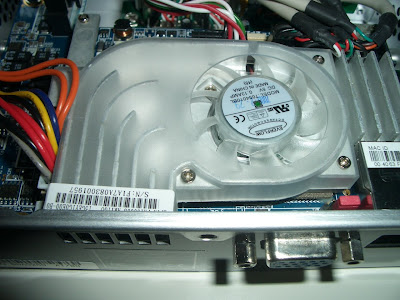Okay the next step is to overclock the GPU (Graphics Processing Unit). An overclocked GPU speeds up gameplay a lot than an overclocked CPU. It turns out to be pretty easy and safe to overclock the GPU. One merely adjusts the clock frequencies (core, shader, memory) via software and there is no risk of over-voltage damage. The only risk is that higher frequencies may result in too high a temperature and cause thermal damage. From the nVidia forums, people claimed that the 9600GT can work safely even up to 80 'C, and the typical load is around 50 - 60 'C.
I tuned the settings using nVidia's control panel, and tested the stability of different values using 3DMark06. I tried Rivatuner for tuning, but it doesn't yet officially support the latest nVidia driver, and anyway the vendor's own software is good enough.
The default frequencies are ...
core : 650 MHz
shader : 1625 MHz
memory (DDR) : 900 MHz
3DMark06 score : 10702
I found out that the shader frequency in the 9600GT is apparently linked to the core frequency by a ratio of 2.5, ie, an increase of 10 MHz in core = 25 MHz in shader, for the 9600GT to be stable.
After a few tries, the best stable frequencies I can get is
core : 775 MHz
shader : 1938 MHz
memory : 975 MHz
3Dmark06 score : 12068
Running C&C3 for some time (at the best graphics settings), I get a highest GPU temperature of around 52 'C, so the temperature is well within limits. I had tweaked the core clock to increase by 19%, and the benchmark reports an increase in performance of around 13%. Excellent! Comparing my 3Dmark06 score with so-called VirtualMark scores (simulated for other configurations that are not overclocked),
mine | 8800GT | other 9600GT | 9800GX2
12068 | 11600 | 10500 | 13600
Now the 9600GT GPU is a mainstream card. nVidia named their cards as x400, x600 or x800, where x400 is for low-end, x600 for mainstream games and x800 is for the best gaming performance. The nVidia 9000 series is a newer architecture compared to the previous the 8000 series generation. Now the 9600GT is supposed to perform a bit worst than the 8800GT normally, but after overclocking its on par! And now my OCed GPU performs not too badly against the 9800GX2 (2 GPU cores), which is the best currently, and cost like 4 times as much. He he ....


























